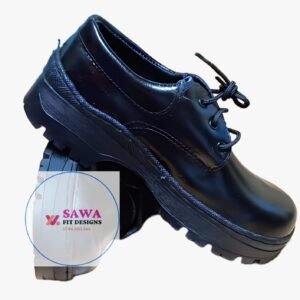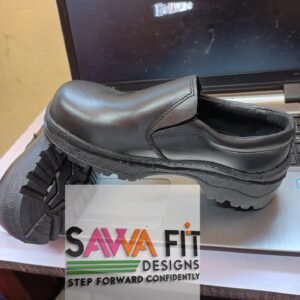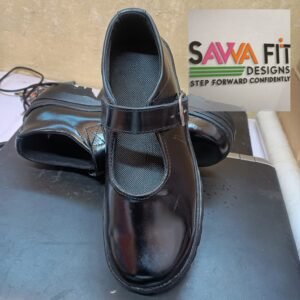What Makes a Good School Shoe?
-
Back to School Shoes -Genuine Pure Leather
Original price was: KSh1,300.KSh1,000Current price is: KSh1,000.Select options This product has multiple variants. The options may be chosen on the product pageClear3234242526272829303133 -
Boys Black School Shoes
Original price was: KSh1,500.KSh1,200Current price is: KSh1,200.Select options This product has multiple variants. The options may be chosen on the product pageClear363835373940 -
Slip-On School Shoes Boys
Original price was: KSh2,500.KSh2,000Current price is: KSh2,000.Select options This product has multiple variants. The options may be chosen on the product pageClear323436382728293031333537 -
Girls School Shoes (Buckle)
Original price was: KSh1,800.KSh1,400Current price is: KSh1,400.Select options This product has multiple variants. The options may be chosen on the product pageClear3837
What Makes a Good School Shoe?
A good school shoe needs to handle daily wear, support growing feet, and stay comfortable through long days. It’s not just about style—though that matters too. Let’s break down what to look for so you can make a practical choice without sacrificing quality.
Key Features of a Reliable School Shoe
Focus on these elements to avoid buying shoes that fall apart or cause discomfort:
- Durability
Kids are hard on shoes. Look for reinforced stitching, thick rubber soles, and scuff-resistant materials like leather or synthetic fabrics. Check the toe box—it should have extra padding or a bumper to protect against dragging feet. - Comfort and Support
- Cushioning: Thin soles can lead to sore feet. Opt for shoes with padded insoles.
- Arch Support: Even if your child doesn’t have flat feet, basic arch support helps posture.
- Breathability: Mesh panels or perforations reduce sweat and odors.
- Fit and Adjustability
Shoes should have room for growth (about a thumb’s width between the toe and shoe end) but not slip at the heel. Adjustable straps or laces let you customize the fit as feet swell during the day. - Weight and Flexibility
Heavy shoes tire legs. Bend the sole—it should flex at the ball of the foot, not the middle.
Materials Matter
Not all materials work equally well for school shoes:
| Material | Pros | Cons |
|---|---|---|
| Leather | Durable, breathable, molds to feet | Expensive, requires maintenance |
| Synthetic | Lightweight, affordable, easy to clean | Less breathable, wears out faster |
| Canvas | Soft, flexible, trendy | Poor weather resistance, minimal support |
Leather is ideal for longevity, but synthetic options work if budget is tight. Avoid canvas for rainy climates or high-impact use.
Style vs. Function: What to Prioritize
Kids often want flashy designs, but practicality should come first. Here’s how to balance both:
- Closure Types: Velcro is quicker for younger kids; laces offer better adjustability for older ones.
- Colors: Darker shades hide scuffs. Let your child pick from options that meet durability criteria.
- Trends: Chunky soles or platform shoes might look cool but can trip kids or strain ankles.
Common Mistakes to Avoid
- Buying “To Grow Into”: Oversized shoes cause blisters and affect walking. Replace shoes when toes reach the end.
- Ignoring Wear Patterns: Check soles every month. Uneven wear can signal posture issues.
- Prioritizing Price Alone: Cheap shoes may save money now but cost more in replacements or foot problems.
How to Test a School Shoe Before Buying
- Press the toe area. It shouldn’t collapse easily.
- Twist the shoe. It should resist twisting to protect ankles.
- Check the insole. Removable insoles allow for orthotics if needed.
- Have your child walk on a hard surface. Listen for loud clicks (a sign of poor cushioning).
When to Replace School Shoes
Even the best shoes don’t last forever. Watch for:
- Worn treads on the sole
- Holes in the toe or heel
- Frayed straps or broken closures
- Complaints of foot pain (after ruling out growth spurts)
Most kids need new shoes every 4–6 months, depending on activity level.
Final Tips
- Shop in the afternoon when feet are slightly swollen.
- Bring the socks your child usually wears to try shoes.
- If one foot is larger, size up for comfort.
A good school shoe isn’t about the brand or the latest trend—it’s about how well it holds up to playgrounds, gym classes, and daily walks. Stick to these guidelines, and you’ll avoid wasting money on shoes that disappoint.
-
Back to School Shoes -Genuine Pure Leather
Original price was: KSh1,300.KSh1,000Current price is: KSh1,000.Select options This product has multiple variants. The options may be chosen on the product pageClear3234242526272829303133 -
Boys Black School Shoes
Original price was: KSh1,500.KSh1,200Current price is: KSh1,200.Select options This product has multiple variants. The options may be chosen on the product pageClear363835373940 -
Slip-On School Shoes Boys
Original price was: KSh2,500.KSh2,000Current price is: KSh2,000.Select options This product has multiple variants. The options may be chosen on the product pageClear323436382728293031333537 -
Girls School Shoes (Buckle)
Original price was: KSh1,800.KSh1,400Current price is: KSh1,400.Select options This product has multiple variants. The options may be chosen on the product pageClear3837
What Makes a Good School Shoe?



